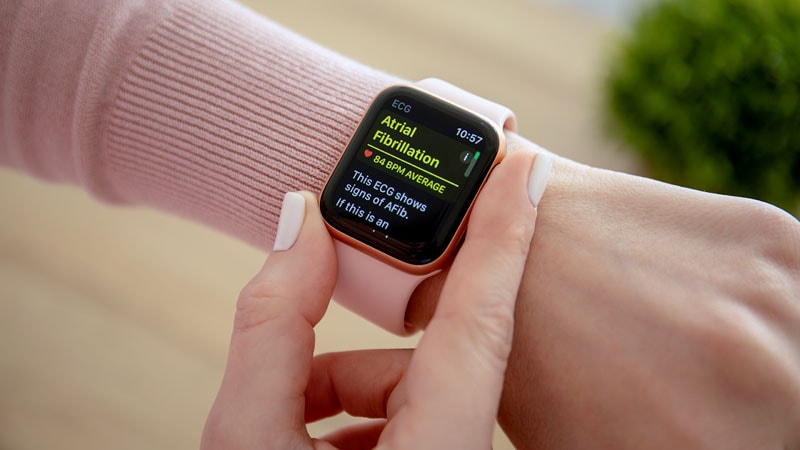
The ability of an Apple Watch to detect atrial fibrillation (AF) is significantly affected by underlying ECG abnormalities such as sinus node dysfunction, atrioventricular (AV) block, or intraventricular conduction delay (IVCD), a single-center study suggests.

Dr Marc Strik
“We were surprised to find that in one in every five patients, the smartwatch ECG failed to produce an automatic diagnosis,” study author Marc Strik, MD, PhD, a clinician at Bordeaux University Hospital in Pessac, France, told Medscape Medical News. “This [failure] was mostly due to insufficient quality of the tracing [60%], but in a third of cases, [34%], it was due to bradycardia, and in some cases, tachycardia, [6%].
“We were also surprised to find that the existence of ventricular conduction disease was associated with a higher likelihood of missing AF,” he said.
The study was published online Oct. 11 in the Canadian Journal of Cardiology.
Abnormalities Affected Detection
The investigators tested the accuracy of the Apple Watch (Apple, Cupertino, California) in detecting AF in patients with various ECG anomalies. All participants underwent 12-lead ECG, followed by a 30-second ECG tracing with an Apple Watch Series 5. The smartwatch’s automated AF detection algorithm gave a result of “no signs of AF,” “AF,” or “not checked for AF (unclassified).”
Unclassified recordings resulted from “low heart rate” (below 50 beats/min), “high heart rate” (above 150 beats/min), “poor recording,” or “inconclusive recording.”
The smartwatch recordings were reviewed by a blinded electrophysiologist who interpreted each tracing and assigned a diagnosis of “AF,” “absence of AF,” or “diagnosis unclear.” To assess interobserver agreement, a second blinded electrophysiologist interpreted 100 randomly selected tracings.
Among the 734 patients (mean age, 66; 58% men) enrolled, 539 (73%) were in normal sinus rhythm (SR), 154 (21%) in AF, 33 in atrial flutter or atrial tachycardia, three in ventricular tachycardia, and five in junctional tachycardia.
Furthermore, 65 (8.9%) had sinus node dysfunction, 21 (2.9%) had second- or third-degree AV block, 39 (5.3%) had a ventricular paced rhythm, 54 (7.4%) had premature ventricular contractions (PVCs), and 132 (18%) had IVCD (right or left bundle branch block or nonspecific IVCD).
Of the 539 patients in normal SR, 437 recordings were correctly diagnosed by the smartwatch. Seven were diagnosed incorrectly as AF, and 95 were not classified.
Of the 187 patients in AF, 129 were correctly diagnosed, 17 were incorrectly diagnosed as SR, and 41 were not classified.
When unclassified ECGs were considered false results, the smartwatch had a sensitivity of 69% and specificity of 81% for AF detection. When unclassified ECGs were excluded from the analysis, sensitivity was 88%, and specificity was 98%.
Compared with patients without the abnormality, the relative risk of having false positive tracings was higher for patients with premature atrial contractions (PACs) or PVCs (risk ratio [RR], 2.9), sinus node dysfunction (RR, 3.71), and AV block (RR, 7.8).
Fifty-eight patients with AF were classified as SR or inconclusive by the smartwatch. Among them, 21 (36%) had an IVCD, 7 (12%) had a ventricular paced rhythm, and 5 (9%) had PACs or PVCs.
The risk of having false negative tracings (missed AF) was higher for patients with IVCD (RR, 2.6) and pacing (RR, 2.47), compared with those without the abnormality.
‘A Powerful Tool’
Overall, cardiac electrophysiologists showed high agreement in differentiating between AF and non-AF, with high interobserver reproducibility. A manual diagnosis was not possible for 10% of tracings because of either poor ECG quality (3%) or unclear P-waves (7%).
Fifty-nine of the 580 patients in SR were misclassified as AF by the experts, and five of the 154 patients in AF were misclassified as SR.
“Our results show that the presence of sinus node dysfunction, second- or third-degree AV block, ventricular paced rhythm, PVCs, and IVCD were more frequently represented in smartwatch misdiagnoses,” wrote the authors. “Patients with PVCs were three times as likely to have false positive AF diagnoses.”
Study limitations included the single-center nature of the study and the fact that patients were recruited in a cardiology office. The latter factor may have influenced the incidence of ECG abnormalities, which was much higher than for the average smartwatch user.
“Even with its limitations, the smartwatch remains a powerful tool that is able to detect AF and multiple other abnormalities,” said Strik. “Missed diagnosis of AF may be less important in real life because of repeated measurements, and algorithms will continue to improve.”
Technology Improving
Commenting on the study for Medscape, Richard C. Becker, MD, director and physician in chief of the University of Cincinnati Heart, Lung, and Vascular Institute, Cincinnati, Ohio, said, “This is exactly the kind of investigation required to improve upon existing detection algorithms that will someday facilitate routine use in patient care. An ability to detect AF in a large proportion of those with the heart rhythm abnormality is encouraging.”

Dr Richard Becker
The findings should not detract from well-conducted studies in otherwise healthy individuals of varied age in whom AF was accurately detected, he added. “Similarly, an automatic diagnosis algorithm for AF, pending optimization and validation in a large and diverse cohort, should be viewed as a communication tool between patients and healthcare providers.”
Patients at risk for developing AF could benefit from continuous monitoring using a smartwatch, said Becker. “Pre-existing heart rhythm abnormalities must be taken into consideration. Optimal utilization of emerging technology to include wearables requires an understanding of performance and limitations. It is best undertaken in coordination with a healthcare provider.”
Andrés F. Miranda-Arboleda, MD, and Adrian Baranchuk, MD, of Kingston Health Sciences Center in Ontario, Canada, conclude in an accompanying editorial, “In a certain manner, the smartwatch algorithms for the detection of AF in patients with cardiovascular conditions are not yet smart enough…but they may soon be.”
The study was supported by the French government. Strik, Miranda-Arboleda, Baranchuk, and Becker reported no conflicts of interest.
Can J Cardiol. Published online Oct. 11, 2022. Full text.
Follow Marilynn Larkin on Twitter: @MarilynnL.
For more news, follow Medscape on Facebook, Twitter, Instagram, and YouTube.
Source: Read Full Article